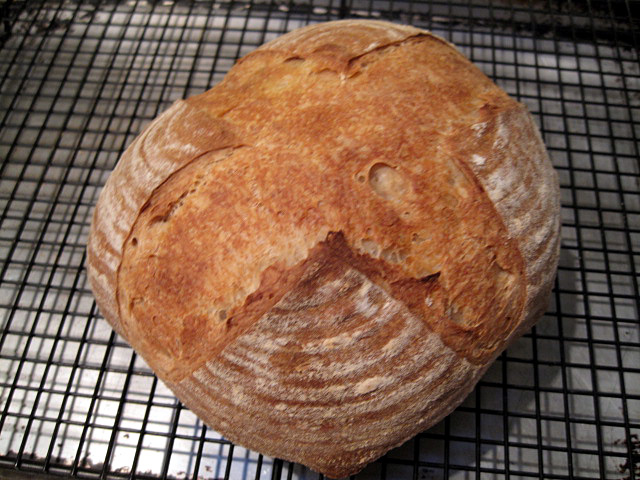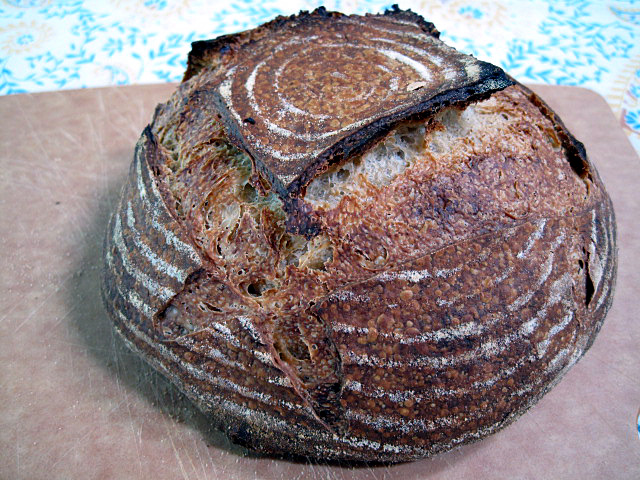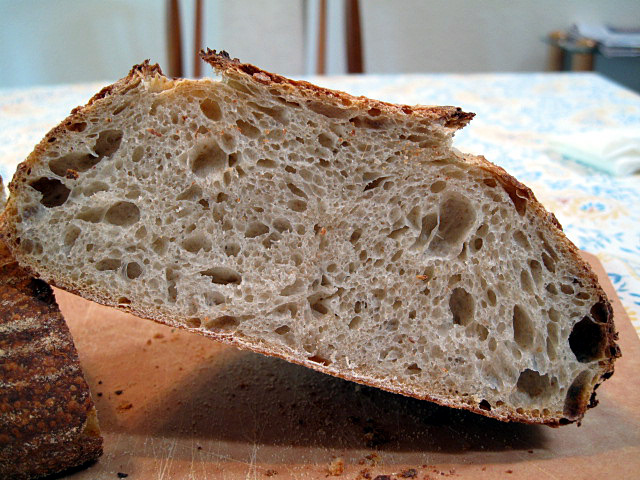Susan from San Diego, of “Magic Bowl” fame, has posted two of her basic sourdough bread recipes. These have been on my lengthy “to bake list” for a long time. The photos of her breads are stunning, and many other TFL members have baked from her recipes and enthused about their results.
This weekend, I baked two boules of her “Original Sourdough” - to be distinguished from her “Ultimate Sourdough.” The latter can be found here:
http://www.thefreshloaf.com/node/6927/well-i-finally-did-it
I made some modifications in procedures which I will describe, but Susan's original “Original Sourdough” formula can be found here:
http://www.thefreshloaf.com/node/8884/susan039s-original-sourdough-3262007
David's Un-original Sourdough after Susan from San Diego's Original Sourdough
Note: This recipe involves 3 “builds” - a “starter,” a “sponge” and the “dough.”
Starter
Active starter 1Tablespoon
Water 15 gms
Bread flour 25 gms
Sponge
Water 240 gms
Bread flour 173 gms
Whole wheat flour 50 gms (I used KAF White Whole Wheat.)
Starter All of the above
Dough
Bread flour 284 gms
Water 60 gms
Olive oil 14 gms
Salt 7.5 gms
Procedures
(I did my mixing in a KitchenAid Accolade.)
Make the Starter by dissolving the active starter in the water in a small bowl, adding the flour and mixing until all the flour is well hydrated. Cover tightly and allow to ferment for about 8 hours. It should be puffy and slightly bubbly. Refrigerate for up to 3 days if you are not ready to use it immediately.
Make the Sponge by dissolving the Starter in the water in a medium-sized bowl. Mix the flours and add them to the dissolved starter. Mix thoroughly and then cover the bowl tightly. Allow the Sponge to ferment until it is bubbly and has expanded - about 8 hours.
Make the dough by dissolving the Sponge in the water and mix in the olive oil in the bowl or your mixer. Mix the flour and salt, add it to the wet ingredients and mix with a spoon or spatula or with the paddle at Speed 1 to a shaggy mass. Cover the bowl and let it rest for 20 minutes to an hour. (This will allow the flour to hydrate and the gluten to start developing.)
Switch to the dough hook and mix at Speed 2 until you have moderate gluten development. (This took me about 10 minutes.) The dough should clean the sides of the bowl but stick to the bottom with a diameter of about 6 inches.
Scrape the dough onto your lightly floured bench and do a couple of stretch and folds. Transfer the dough to a lightly oiled bowl and cover tightly. (I use a 8 cup glass measuring “cup” with a tight-fitting plastic cover.) Stretch and fold the dough 3 times at 30 minute intervals, then allow to rise in the bowl until double the original volume – about 4 hours in my coolish kitchen.
Divide the dough into 2 equal parts and pre-shape into rounds. Cover and allow to rest for 10-15 minutes. Then, shape the pieces into boules and place each in a floured banneton. Cover with plastic wrap, a towel or place the bannetons in food grade plastic bags.
At this point, you can either allow the loaves to proof until 1.5 times their original size or retard them for 8-12 hours in the refrigerator. (For this bake, I proofed and baked one boule immediately and retarded the other.) If you retard the loaves, allow an extra hour or two for proofing – about 4 hours from when you take them out of refrigeration until you bake them.
Forty-five minutes (or 45-60 minutes, if using a baking stone) before baking, pre-heat your oven to 480F with a sheet pan or baking stone in the oven. (Make sure your sheet pan is large enough to form a base for the cover you will be placing over the loaf. See below. I used a heavy-gauge black steel, non-stick sheet pan that is larger than the standard “half sheet” size.)
When the loaf is proofed, transfer it to a peel dusted with semolina or corn meal, load it onto your sheet pan or stone and immediately cover it with a stainless steel bowl that has been pre-heated with hot tap water. (Dump the water but do not dry the bowl just before loading the loaf in the oven.)
Bake for 15 minutes, then remove the bowl from the oven, close the door and lower the temperature to 450F. Bake for another 15-18 minutes until the loaf is nicely colored and its internal temperature is at least 205F. Turn off the oven and leave the door ajar with the loaf in it for another 5-10 minutes to dry the crust.
Cool the loaf on a rack completely before slicing.
The loaf that was baked without overnight cold retarding was much like a French pain au levain. Right after cooling, it was only very mildly sour and had a nice wheaty flavor. Thirty-six hours later, it had a more pronounced but still mild sourness. The flavors had melded and were improved, to my taste. As you can see, the crust was rather light-colored. There was almost no coloration at the point I removed the bowl. The boule had moderate oven spring but great bloom. This is typical of the results I get when I bake loaves covered in this manner. The crust was crisp, and the crumb was nice and open but chewy.

Susan from San Diego's Sourdough (Not cold retarded)

Susan from San Diego's Sourdough (Not cold retarded) Crumb
I baked the cold retarded loaf the next day. This time, I baked the loaf covered for the first 15 minutes, but on a baking stone rather than a sheet pan. Also, I preheated the oven to 500F then turned it down after loading the loaf. I baked at 450F for 30 minutes total, then left the loaf in the turned off oven with the door ajar for another 5 minutes.
As you can see, the second loaf had significantly greater oven spring. I think this was due to the hotter initial temperature and, maybe, the stone. Also, the crust is significantly darker, which I prefer in this type of bread.

Susan from San Diego's "Original Sourdough" baked after cold retardation.

Susan from San Diego's "Original Sourdough" baked after cold retardation - Crumb
This loaf had a crunchier crust and significantly more sour flavor than the loaf that had not been cold retarded. The crumb was chewy but maybe a bit less than the loaf baked the night before. To my taste, this loaf was just about perfect - very close to my personal ideal sourdough bread. I bet it's going to be even better the next day.
Thanks Susan!
David